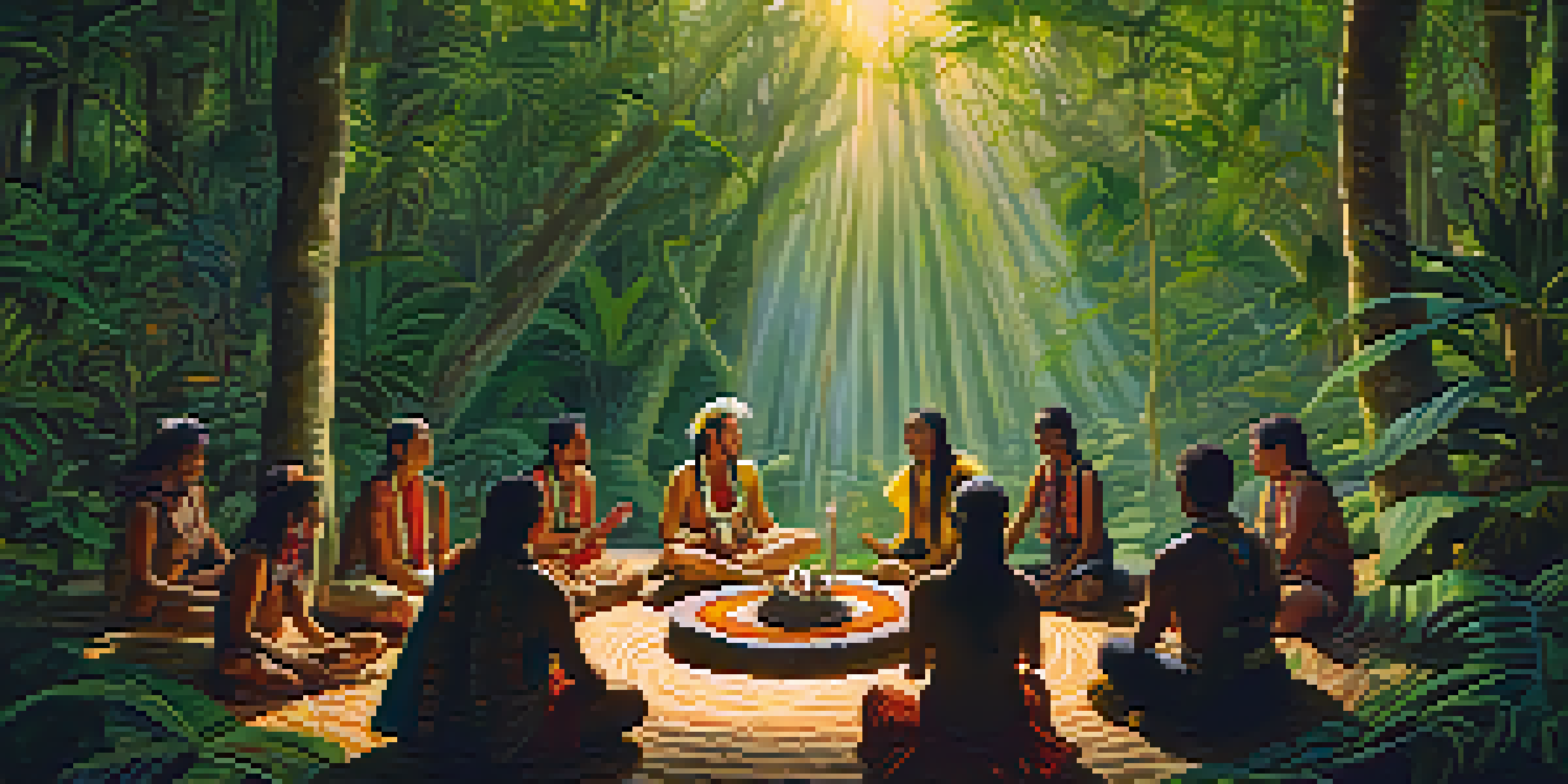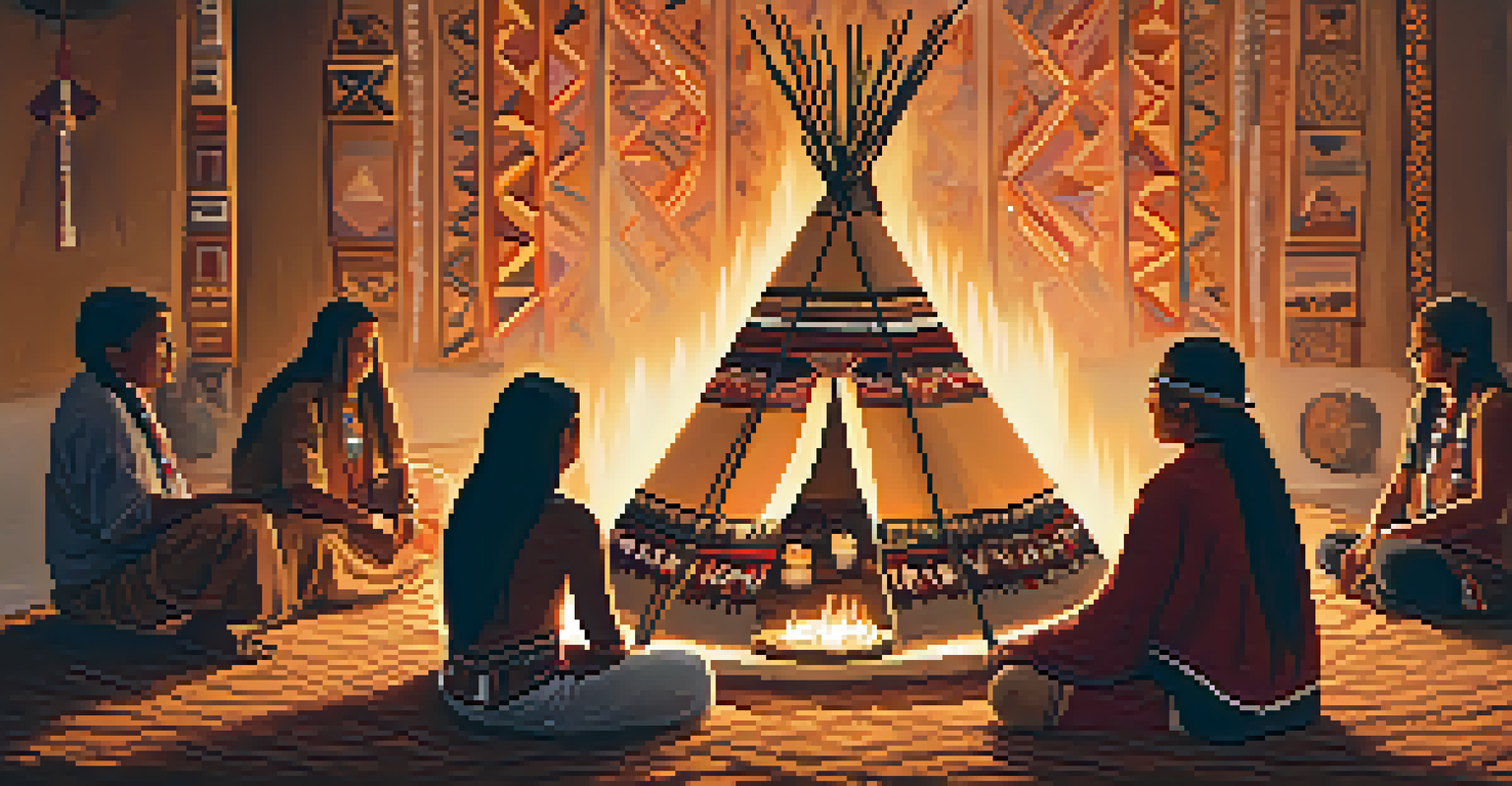Psychedelics in Indigenous Cultures: A Historical Perspective

Understanding Psychedelics: A Brief Overview
Psychedelics are substances that can alter perception, mood, and cognition. Often derived from plants or fungi, these compounds have been used for centuries in various cultures. Understanding their effects can help us appreciate their significance in Indigenous practices.
Psychedelics are not just substances; they are tools for spiritual exploration and healing, deeply woven into the fabric of Indigenous cultures.
In many Indigenous cultures, psychedelics are not just recreational but are seen as tools for spiritual exploration and healing. They facilitate deep introspection and connection to the natural world. This sacred use contrasts sharply with modern perceptions of these substances.
The historical context of psychedelics reveals a rich tapestry of beliefs and practices. By viewing them through this lens, we can better understand their role in rituals and community life across different Indigenous societies.
Cultural Significance of Psychedelics in Indigenous Practices
For many Indigenous groups, psychedelics play a vital role in spiritual ceremonies. They are often used to connect with ancestors, seek guidance, or heal. This cultural significance highlights their importance beyond mere substance use.

In rituals, substances like peyote, ayahuasca, and psilocybin mushrooms serve as gateways to profound experiences. Participants often report feelings of unity, insight, and transcendence. Such experiences are integral to the community's worldview and identity.
Psychedelics in Indigenous Healing
Many Indigenous cultures use psychedelics as vital tools for spiritual exploration and healing.
Moreover, these practices are often steeped in tradition, passed down through generations. Elders guide younger members in their use, ensuring that the knowledge and respect for these substances are maintained.
Rituals and Ceremonies Involving Psychedelics
Many Indigenous cultures incorporate psychedelics into their rituals, which can vary widely from one group to another. For instance, the Native American Church uses peyote in its ceremonies to promote healing and connection to the divine. These rituals often involve songs, prayers, and communal sharing.
The future of psychedelics within Indigenous cultures hinges on the recognition of rights and the respect for the sacred traditions that have been passed down through generations.
In the Amazon, ayahuasca ceremonies led by shamans are common. Participants seek visions or insights that can guide their lives. These experiences are often accompanied by a sense of community and support, reinforcing social bonds.
Such ceremonies are not just about the psychedelic experience but also about fostering a deeper connection to nature and the cosmos. They encourage participants to reflect on their place in the world and their relationships with others.
Psychedelics as Healing Tools in Indigenous Medicine
Healing is a central theme in the use of psychedelics within Indigenous cultures. Many believe that these substances can help treat physical and psychological ailments. Traditional healers often incorporate them into their practices for this reason.
For example, the use of psilocybin mushrooms in some cultures is linked to treatments for depression and anxiety. The insights gained during the experience can lead to profound changes in perspective and emotional healing.
Cultural Significance and Rituals
Psychedelics are integral to rituals that foster community connection, ancestral guidance, and personal insight.
This approach to healing contrasts with Western medicine, which often focuses solely on symptoms. Indigenous practices emphasize holistic healing, considering the mind, body, and spirit as interconnected.
Contemporary Perspectives on Indigenous Psychedelic Use
In recent years, there has been a resurgence of interest in psychedelics, particularly within the context of Indigenous practices. Many people are seeking authentic experiences that connect them to the earth and their spiritual side. This curiosity often leads them to Indigenous ceremonies.
However, this interest raises ethical questions about cultural appropriation. As outsiders participate in these sacred practices, it is essential to respect the traditions and intent behind them. Understanding the cultural significance is crucial to honoring their origins.
Furthermore, Indigenous leaders are becoming more vocal about the importance of preserving their rituals and protecting their knowledge. They advocate for the responsible use of psychedelics and emphasize that these practices are not mere trends but sacred traditions.
Challenges Faced by Indigenous Cultures Regarding Psychedelics
Despite the rich history of psychedelics in Indigenous cultures, these practices face numerous challenges today. Colonialism, legal restrictions, and stigma surrounding drug use have marginalized these traditions. As a result, many Indigenous groups struggle to maintain their practices in the face of external pressures.
Moreover, the commercialization of psychedelics poses a threat to the authenticity of traditional practices. As these substances gain popularity, there is a risk of their cultural significance being lost. This commodification often overlooks the deep spiritual and communal aspects of their use.
Challenges and Future Perspectives
Indigenous practices face challenges from commercialization and cultural appropriation, necessitating advocacy for preservation and respect.
Indigenous communities are actively working to reclaim their narratives and educate others about their practices. By sharing their experiences and knowledge, they aim to combat stereotypes and promote understanding of the cultural importance of psychedelics.
The Future of Psychedelics in Indigenous Cultures
Looking ahead, the future of psychedelics in Indigenous cultures is a complex and evolving landscape. As more people become aware of the benefits, there is potential for greater appreciation of these traditions. This could lead to increased respect for Indigenous knowledge and practices.
However, this future also hinges on the recognition of Indigenous rights and sovereignty. Protecting these cultural practices requires advocacy and support for Indigenous communities. Empowerment and respect for their wisdom are essential in navigating this evolving conversation.

Ultimately, the future of psychedelics in Indigenous cultures will depend on a balance between preservation and adaptation. By honoring the past while engaging with contemporary discussions, these communities can continue to thrive and pass on their rich heritage.